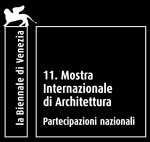General Outline Of the 11th Architecture Exhibition
Posted by Gyula Július on April 7th, 2008, filed in documents
The 11th International Architecture Exhibition, directed by Aaron Betsky and entitled Out There: Architecture Beyond Building and organised by La Biennale di Venezia presided over by Paolo Baratta, will take place in Venice from Sunday, September 14th to Sunday, November 23rd 2008. The preview will be on September 11th – 12th – 13th.
According to Aaron Betsky –for six years director of the Netherlands Architecture Institute (NAI) in Rotterdam, one of the most prestigious museums and architecture centres in the world, and from last year Director of the Cincinnati Art Museum– the 11th Architecture Biennale, entitled Out There. Architecture Beyond Building, “points out what should be an obvious fact: architecture is not building.
Buildings are objects and the act of building leads to such objects, but architecture is something else. It is the way we think and talk about buildings, how we represent them, how we build them. This is architecture. More generally, architecture is a way of representing, shaping and perhaps even offering critical alternatives to the human-made environment. In this world it is not enough to keep the rain out, create room for office cubicles, or fit into a context that either changes continually or becomes artificially frozen. In fact, buildings are not enough. They are the tombs of architecture, the residue of the desire to make another world, a better world, and a world open to possibilities beyond the everyday.
In a concrete sense, architecture is that which allows us to be at home in the world. That could mean producing homes, offices or other places where we live, work, gather or recreate. However, the production of such buildings has become so defined by codes –financial codes, building codes, life and safety codes, computer codes, codes of appearance and behavior—that architecture has very little to do with the way they finally appear.
In isolated situations, such as when a rich person wants a house or a museum wants a cultural artifact, we can find instances of architecture that sensually and sensibly shapes our environment in such a way that it allows us know where we are.
At the same time, fabulous spaces are possible. We can see them in film and in art, where visions of other places unfold in front of our eyes. We can inhabit them in the highly defined spaces that cocoon around us, whether they are the private interior or in hotel rooms, or in the clubs, the restaurants and the boutiques that have become our gathering spaces. We can watch them grow around us in the carefully planned landscapes that have become our last true public spaces.
These images and spaces are worth looking at not just because they are beautiful, but because we are confronting design challenges for which buildings are not enough. How are we going to figure out how to do sprawl right, for instance? If our cities are bleeding out into concatenations of human dwellings that reach across the landscape without any concern for either the environment or social coherence, how can we create an architecture that uses the landscape wisely, frames a relationship to that world and to each other, allows us to be at home and connects us to a larger social, economic and physical fabric? How can we be at home at all in a world in which the continual movement of goods, people and information continually erodes all sense of permanence from any place? How can we construct a physical order that can become a stage on which we can live our lives in concert with others if the constructions that allow us live and play our roles are increasingly invisible results of communications and computer technologies?
Maybe we need to see architecture first of all as way of figuring out what we need to build -and what to unbuild. How can we make spaces that make sense and are sensual? Can we construct literal stages or notional moments of coherence? Can we reveal, appropriate and domesticate those forces, usually of a technological nature, that control our daily lives in such a way that we can feel at home in our modern world?
To do this, perhaps what we need is slow space -not stopped space, not utopia, but also not business usual. We need some icons and some enigmas to make us wonder. We need experiments, a few provisional structures, a few sketches or some maps of how we can move beyond the constructions and constrictions of building to create an architecture that does not solve problems, but poses, frames and articulates them. We need an architecture that questions reality.
This is the challenge the 11th Venice Architecture Biennale takes up. It seeks to collect and encourage experimentation in architecture. Such experimentation can take the form of momentary constructions, visions of other worlds, or the building blocks of a better world. This Biennale does not want to present buildings that are already in existence and can be enjoyed in real life. It does not want to propose abstract solutions to social problems, but wants to see if architecture, by experimenting in and on the real world, can offer some concrete forms or seductive images. The use of new technologies is certainly something to consider in such experimentation, but so are the techniques developed outside of what we usually think of as the world of architecture, such as art, interior design, film, landscape architecture and performance. In a concrete sense, the use of collage and assemblage, of re-use and reconstruction, of unbuilding and deformation, of ephemeral form and utopian or dystopian imagery, and the posing of the ugly, the unformed and the undecided or blurred are all possibilities. In reality, there is a secret history of architecture separate from the progression of styles and the vagaries of technological perfection that has used such forces to produce an other architecture, and it is in this tradition that the 11th Venice Architecture Biennale places itself”.
Out There: Architecture Beyond Building will present, in the Venice Arsenale, large-scale site specific installations that will ask the question how we can be at home in the modern world. There it will offer an alternative to urban planning in viral architecture . It will present manifestos for an architecture beyond building. It will show visions that might become the building blocks for such an architecture. It will finally bring us back to Eden. Participants will include Diller Scofidio+Renfro, UN Studio, Massimiliano Fuksas, Nigel Coates, Erik Adigard, Work Architecture, Droog Design, Philippe Rahm and Kathryn Gustafson, as well as architects who will create viral forms.
In the Padiglione Italia, a survey of experimental architecture will show the work firms from around the world who are engaged in such work. This survey will be anchored by small monographic shows on firms whose work has been based on such experimentation: Frank Gehry, Herzog & de Meuron, Morphosis, Zaha Hadid and Coop Himmelb(l)au. A presentation of experiments one can find on the World Wide Web and beyond will further enhance this collection of forms and images.
The 11th Venice Architecture Biennale is being assembled by Aaron Betsky with the help of an international curatorial team consisting of Francesco Delogu, Emiliano Gandolfi, Casey Jones, Reed Kroloff, Marcin Szczelina and Saskia van Stein. The Amsterdam firm of Thonik will work with him to design the 11th Venice Architecture Biennale’s identity and presentations.
The 11th International Architecture Exhibition will also present numerous National Participations with exhibitions inside the Pavilions at Giardini and through the historic centre in Venice.
Collateral Events organised by cultural institutions from all over the world will also be part of the exhibition, setting up their shows in Venice.
The catalogue of the 11th International Architecture Exhibition will be published by Marsilio.
The official website is www.labiennale.org








Leave a Reply
You must be logged in to post a comment.